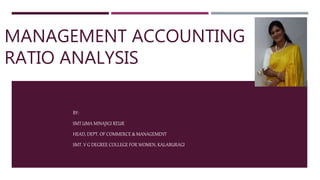
Ratio Analysis - Debtors Turnover Ratio
- 1. MANAGEMENT ACCOUNTING RATIO ANALYSIS BY: SMT.UMA MINAJIGI REUR HEAD, DEPT. OF COMMERCE & MANAGEMENT SMT. V G DEGREE COLLEGE FOR WOMEN, KALABURAGI
- 2. MANAGEMENT ACCOUNTING RATIO ANALYSIS TURNOVER RATIOS – 2 DEBTORS TURNOVER RATIO
- 3. Classification of Accounting Ratio Types of ratios are given below: 1. Liquidity Ratios 2. Leverage Ratio 3. Turnover Ratio 4. Profitability Ratio
- 4. Turnover Ratios or Activity Ratios or Performance Ratios Turnover ratios are used to determine how efficiently the financial assets and liabilities of an organization have been used for the purpose of generating revenues. These ratios measure the operating efficiency of an enterprise. The types of Turnover ratios are: – 1. Inventory Turnover Ratio or Stock Turnover Ratio. 2. Debtors Turnover Ratio. 3. Creditors Turnover Ratio. 4. Cash Turnover Ratio. 5. Working Capital Turnover Ratio. 6. Fixed Assets Turnover Ratio. 7. Capital Turnover Ratio or Sales to Net Worth Ratio.
- 5. DEBTORS TURNOVER RATIO The Debtors Turnover Ratio also called as Receivables Turnover Ratio or Debtors velocity shows how quickly the credit sales are converted into the cash. This ratio measures the efficiency of a firm in managing and collecting the credit issued to the customers. It is calculated by the following formula: De𝐛𝐭𝐨𝐫𝐬 𝐓𝐮𝐫𝐧𝐨𝐯𝐞𝐫 𝐑𝐚𝐭𝐢𝐨 = 𝐍𝐞𝐭 𝐂𝐫𝐞𝐝𝐢𝐭 𝐒𝐚𝐥𝐞𝐬 𝐀𝐯𝐞𝐫𝐚𝐠𝐞 𝐃𝐞𝐛𝐭𝐨𝐫𝐬
- 6. DEBTORS TURNOVER RATIO Net Credit Sales = Total Sales – Cash Sales – Sales Returns Calculation of Average Debtors : 𝐀𝐯𝐞𝐫𝐚𝐠𝐞 𝐃𝐞𝐛𝐭𝐨𝐫𝐬 = 𝐎𝐩𝐞𝐧𝐢𝐧𝐠 𝐃𝐞𝐛𝐭𝐨𝐫𝐬 + 𝐂𝐥𝐨𝐬𝐢𝐧𝐠 𝐃𝐞𝐛𝐭𝐨𝐫𝐬 𝟐 Interpretation: Standard credit period is 30 days If the credit period is more than 30 days it indicates that the concern is not efficient. If the credit period is less than 30 days it indicates that the concern is efficient.
- 7. DEBTORS TURNOVER RATIO Calculation of Average Debtors (if B/R is given): 𝐀𝐯𝐞𝐫𝐚𝐠𝐞 𝐃𝐞𝐛𝐭𝐨𝐫𝐬 = 𝐎𝐩𝐞𝐧𝐢𝐧𝐠 𝐃𝐞𝐛𝐭𝐨𝐫𝐬 + 𝐎𝐩𝐞𝐧𝐢𝐧𝐠 𝐁/𝐑 + 𝐂𝐥𝐨𝐬𝐢𝐧𝐠 𝐃𝐞𝐛𝐭𝐨𝐫𝐬 + 𝐂𝐥𝐨𝐬𝐢𝐧𝐠 𝐁/𝑹 𝟐
- 8. AVERAGE COLLECTION PERIOD The Average Collection Period, also called as Debt Collection Period, shows how much time business takes to realize the credit sales. Simply, how long will it take to recover payments from the debtors against the credit sales? It is calculated by dividing the number of months or days or weeks by the debtors turnover ratio. A𝐯𝐞𝐫𝐚𝐠𝐞 𝐂𝐨𝐥𝐥𝐞𝐜𝐭𝐢𝐨𝐧 𝐏𝐞𝐫𝐢𝐨𝐝 𝐌𝐨𝐧𝐭𝐡𝐬 = 𝐍𝐮𝐦𝐛𝐞𝐫 𝐨𝐟 𝐦𝐨𝐧𝐭𝐡𝐬 𝐃𝐞𝐛𝐭𝐨𝐫𝐬 𝐭𝐮𝐫𝐧𝐨𝐯𝐞𝐫 𝐫𝐚𝐭𝐢𝐨
- 9. AVERAGE COLLECTION PERIOD A𝐯𝐞𝐫𝐚𝐠𝐞 𝐂𝐨𝐥𝐥𝐞𝐜𝐭𝐢𝐨𝐧 𝐏𝐞𝐫𝐢𝐨𝐝 𝐌𝐨𝐧𝐭𝐡𝐬 = 𝐍𝐮𝐦𝐛𝐞𝐫 𝐨𝐟 𝐦𝐨𝐧𝐭𝐡𝐬 𝐃𝐞𝐛𝐭𝐨𝐫𝐬 𝐭𝐮𝐫𝐧𝐨𝐯𝐞𝐫 𝐫𝐚𝐭𝐢𝐨 A𝐯𝐞𝐫𝐚𝐠𝐞 𝐂𝐨𝐥𝐥𝐞𝐜𝐭𝐢𝐨𝐧 𝐏𝐞𝐫𝐢𝐨𝐝 𝐖𝐞𝐞𝐤𝐬 = 𝐍𝐮𝐦𝐛𝐞𝐫 𝐨𝐟 𝐰𝐞𝐞𝐤𝐬 𝐢𝐧 𝐚 𝐲𝐞𝐚𝐫 𝐃𝐞𝐛𝐭𝐨𝐫𝐬 𝐭𝐮𝐫𝐧𝐨𝐯𝐞𝐫 𝐫𝐚𝐭𝐢𝐨 A𝐯𝐞𝐫𝐚𝐠𝐞 𝐂𝐨𝐥𝐥𝐞𝐜𝐭𝐢𝐨𝐧 𝐏𝐞𝐫𝐢𝐨𝐝 𝐃𝐚𝐲𝐬 = 𝐍𝐮𝐦𝐛𝐞𝐫 𝐨𝐟 𝐝𝐚𝐲𝐬 𝐢𝐧 𝐚 𝐲𝐞𝐚𝐫 𝐃𝐞𝐛𝐭𝐨𝐫𝐬 𝐭𝐮𝐫𝐧𝐨𝐯𝐞𝐫 𝐫𝐚𝐭𝐢𝐨
- 10. AVERAGE COLLECTION PERIOD A𝐯𝐞𝐫𝐚𝐠𝐞 𝐂𝐨𝐥𝐥𝐞𝐜𝐭𝐢𝐨𝐧 𝐏𝐞𝐫𝐢𝐨𝐝 = 𝐀𝐯𝐞𝐫𝐚𝐠𝐞 𝐃𝐞𝐛𝐭𝐨𝐫𝐬 𝐍𝐞𝐭 𝐜𝐫𝐞𝐝𝐢𝐭 𝐬𝐚𝐥𝐞𝐬 𝐩𝐞𝐫 𝐝𝐚𝐲 A𝐯𝐞𝐫𝐚𝐠𝐞 𝐂𝐨𝐥𝐥𝐞𝐜𝐭𝐢𝐨𝐧 𝐏𝐞𝐫𝐢𝐨𝐝 𝐖𝐞𝐞𝐤𝐬 = 𝐃𝐞𝐛𝐭𝐨𝐫𝐬 𝐂𝐫𝐞𝐝𝐢𝐭 𝐒𝐚𝐥𝐞𝐬 * No. of days in a year 𝐀𝐯𝐞𝐫𝐚𝐠𝐞 𝐃𝐞𝐛𝐭𝐨𝐫𝐬 = 𝐎𝐩𝐞𝐧𝐢𝐧𝐠 𝐃𝐞𝐛𝐭𝐨𝐫𝐬 + 𝐂𝐥𝐨𝐬𝐢𝐧𝐠 𝐃𝐞𝐛𝐭𝐨𝐫𝐬 𝟐
- 11. Illustration 1: From the following information calculate Debtors turnover ratio (DTR) and Average collection period (ACP). Total Sales Rs.6,40,000, Cash sales Rs. 4,00,000, Debtors at beginning Rs. 20,000, debtors at the end Rs. 28,000. Bills receivable at beginning Rs. 16,000 and B/R at the end Rs.24,000. Solution 1: Net Credit Sales = Total Sales – Cash Sales – Sales Returns Net Credit Sales = 6,40,000 – 4,00,000 – Nil Net Credit Sales = 2,40,000
- 12. 𝐀𝐯𝐞𝐫𝐚𝐠𝐞 𝐃𝐞𝐛𝐭𝐨𝐫𝐬 = 𝐎𝐩𝐞𝐧𝐢𝐧𝐠 𝐃𝐞𝐛𝐭𝐨𝐫𝐬 + 𝐎𝐩𝐞𝐧𝐢𝐧𝐠 𝐁/𝐑 + 𝐂𝐥𝐨𝐬𝐢𝐧𝐠 𝐃𝐞𝐛𝐭𝐨𝐫𝐬 + 𝐂𝐥𝐨𝐬𝐢𝐧𝐠 𝐁/𝑹 𝟐 𝐀𝐯𝐞𝐫𝐚𝐠𝐞 𝐃𝐞𝐛𝐭𝐨𝐫𝐬 = 𝟐𝟎, 𝟎𝟎𝟎 + 𝟏𝟔, 𝟎𝟎𝟎 + 𝟐𝟖, 𝟎𝟎𝟎 + 𝟐𝟒, 𝟎𝟎𝟎 𝟐 Total Sales Rs.6,40,000, Cash sales Rs. 4,00,000, Debtors at beginning Rs. 20,000, debtors at the end Rs. 28,000. Bills receivable at beginning Rs. 16,000 and B/R at the end Rs.24,000. 𝐀𝐯𝐞𝐫𝐚𝐠𝐞 𝐃𝐞𝐛𝐭𝐨𝐫𝐬 = 𝟑𝟔,𝟎𝟎𝟎+𝟓𝟐,𝟎𝟎𝟎 𝟐 = 44,000 De𝐛𝐭𝐨𝐫𝐬 𝐓𝐮𝐫𝐧𝐨𝐯𝐞𝐫 𝐑𝐚𝐭𝐢𝐨 = 𝐍𝐞𝐭 𝐂𝐫𝐞𝐝𝐢𝐭 𝐒𝐚𝐥𝐞𝐬 𝐀𝐯𝐞𝐫𝐚𝐠𝐞 𝐃𝐞𝐛𝐭𝐨𝐫𝐬 De𝐛𝐭𝐨𝐫𝐬 𝐓𝐮𝐫𝐧𝐨𝐯𝐞𝐫 𝐑𝐚𝐭𝐢𝐨 = 𝟐,𝟒𝟎,𝟎𝟎𝟎 𝟒𝟒,𝟎𝟎𝟎 = 5.45 times
- 13. A𝐯𝐞𝐫𝐚𝐠𝐞 𝐂𝐨𝐥𝐥𝐞𝐜𝐭𝐢𝐨𝐧 𝐏𝐞𝐫𝐢𝐨𝐝 𝐌𝐨𝐧𝐭𝐡𝐬 = 𝐍𝐮𝐦𝐛𝐞𝐫 𝐨𝐟 𝐦𝐨𝐧𝐭𝐡𝐬 𝐃𝐞𝐛𝐭𝐨𝐫𝐬 𝐭𝐮𝐫𝐧𝐨𝐯𝐞𝐫 𝐫𝐚𝐭𝐢𝐨 A𝐯𝐞𝐫𝐚𝐠𝐞 𝐂𝐨𝐥𝐥𝐞𝐜𝐭𝐢𝐨𝐧 𝐏𝐞𝐫𝐢𝐨𝐝 𝐖𝐞𝐞𝐤𝐬 = 𝐍𝐮𝐦𝐛𝐞𝐫 𝐨𝐟 𝐰𝐞𝐞𝐤𝐬 𝐢𝐧 𝐚 𝐲𝐞𝐚𝐫 𝐃𝐞𝐛𝐭𝐨𝐫𝐬 𝐭𝐮𝐫𝐧𝐨𝐯𝐞𝐫 𝐫𝐚𝐭𝐢𝐨 A𝐯𝐞𝐫𝐚𝐠𝐞 𝐂𝐨𝐥𝐥𝐞𝐜𝐭𝐢𝐨𝐧 𝐏𝐞𝐫𝐢𝐨𝐝 𝐃𝐚𝐲𝐬 = 𝐍𝐮𝐦𝐛𝐞𝐫 𝐨𝐟 𝐝𝐚𝐲𝐬 𝐢𝐧 𝐚 𝐲𝐞𝐚𝐫 𝐃𝐞𝐛𝐭𝐨𝐫𝐬 𝐭𝐮𝐫𝐧𝐨𝐯𝐞𝐫 𝐫𝐚𝐭𝐢𝐨 A𝐯𝐞𝐫𝐚𝐠𝐞 𝐂𝐨𝐥𝐥𝐞𝐜𝐭𝐢𝐨𝐧 𝐏𝐞𝐫𝐢𝐨𝐝 𝐌𝐨𝐧𝐭𝐡𝐬 = 𝟏𝟐 𝟓.𝟒𝟓 = 2.2 months A𝐯𝐞𝐫𝐚𝐠𝐞 𝐂𝐨𝐥𝐥𝐞𝐜𝐭𝐢𝐨𝐧 𝐏𝐞𝐫𝐢𝐨𝐝 𝐖𝐞𝐞𝐤𝐬 = 𝟓𝟐 𝟓.𝟒𝟓 = 9.54 weeks A𝐯𝐞𝐫𝐚𝐠𝐞 𝐂𝐨𝐥𝐥𝐞𝐜𝐭𝐢𝐨𝐧 𝐏𝐞𝐫𝐢𝐨𝐝 𝐃𝐚𝐲𝐬 = 𝟑𝟔𝟓 𝟓.𝟒𝟓 = 𝟔𝟕 𝐝𝐚𝐲𝐬
- 14. Illustration 2: From the following information calculate Debtors turnover ratio (DTR). Total Sales Rs.6,00,000, Cash sales Rs. 1,00,000, Debtors at beginning Rs. 20,000, debtors at the end Rs. 30,000. Solution 2: Net Credit Sales = Total Sales – Cash Sales – Sales Returns Net Credit Sales = 6,00,000 – 1,00,000 – Nil Net Credit Sales = 5,00,000
- 15. 𝐀𝐯𝐞𝐫𝐚𝐠𝐞 𝐃𝐞𝐛𝐭𝐨𝐫𝐬 = 𝐎𝐩𝐞𝐧𝐢𝐧𝐠 𝐃𝐞𝐛𝐭𝐨𝐫𝐬 + 𝐂𝐥𝐨𝐬𝐢𝐧𝐠 𝐃𝐞𝐛𝐭𝐨𝐫𝐬 𝟐 𝐀𝐯𝐞𝐫𝐚𝐠𝐞 𝐃𝐞𝐛𝐭𝐨𝐫𝐬 = 𝟐𝟎,𝟎𝟎𝟎+𝟑𝟎,𝟎𝟎𝟎 𝟐 = 25,000 Total Sales Rs.6,00,000, Cash sales Rs. 1,00,000, Debtors at beginning Rs. 20,000, debtors at the end Rs. 30,000. De𝐛𝐭𝐨𝐫𝐬 𝐓𝐮𝐫𝐧𝐨𝐯𝐞𝐫 𝐑𝐚𝐭𝐢𝐨 = 𝐍𝐞𝐭 𝐂𝐫𝐞𝐝𝐢𝐭 𝐒𝐚𝐥𝐞𝐬 𝐀𝐯𝐞𝐫𝐚𝐠𝐞 𝐃𝐞𝐛𝐭𝐨𝐫𝐬 De𝐛𝐭𝐨𝐫𝐬 𝐓𝐮𝐫𝐧𝐨𝐯𝐞𝐫 𝐑𝐚𝐭𝐢𝐨 = 𝟓,𝟎𝟎,𝟎𝟎𝟎 𝟐𝟓,𝟎𝟎𝟎 = 20 times
- 16. THANK YOU Watch Next Video & PPT For Creditors Turnover Ratio
